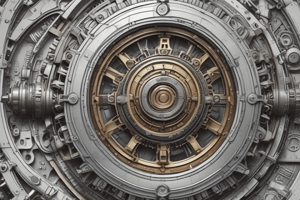Podcast
Questions and Answers
What is the result of uniformly heating steel above hardening temperatures, followed by cooling in air?
What is the result of uniformly heating steel above hardening temperatures, followed by cooling in air?
- Hardening
- Tempering
- Normalizing (correct)
- Annealing
Which machine tool is designed to machine flat or plane surfaces using a single-point cutting tool?
Which machine tool is designed to machine flat or plane surfaces using a single-point cutting tool?
- Power saw
- Planer (correct)
- Tool grinder
- Shaper
What type of material is capable of wearing away a softer substance?
What type of material is capable of wearing away a softer substance?
- Tungsten
- Abrasive (correct)
- Corrosive
- Alloy
What does the imaginary circle passing through the contact points of meshing gear teeth represent?
What does the imaginary circle passing through the contact points of meshing gear teeth represent?
Which instrument is used to true and align machine tools, inspect finished parts, and compare measurements?
Which instrument is used to true and align machine tools, inspect finished parts, and compare measurements?
Which component converts rotary motion into reciprocating motion when meshed with a gear?
Which component converts rotary motion into reciprocating motion when meshed with a gear?
Which of the following is NOT a type of tap used for cutting threads in holes?
Which of the following is NOT a type of tap used for cutting threads in holes?
What hand tool is specifically designed to measure engine crank web deflections?
What hand tool is specifically designed to measure engine crank web deflections?
Which of these terms isn't commonly used to classify fits in mechanical engineering?
Which of these terms isn't commonly used to classify fits in mechanical engineering?
Which diameter coincides with the top of an internal gear's teeth?
Which diameter coincides with the top of an internal gear's teeth?
What alloy is primarily composed of copper and zinc?
What alloy is primarily composed of copper and zinc?
Which type of gauge consists of thin metal strips of varying thicknesses, used for checking clearances?
Which type of gauge consists of thin metal strips of varying thicknesses, used for checking clearances?
What heat treatment process involves reheating steel below its transformation range?
What heat treatment process involves reheating steel below its transformation range?
Which machine tool is best suited for producing flat surfaces on workpieces too large for a shaper?
Which machine tool is best suited for producing flat surfaces on workpieces too large for a shaper?
Which device is specifically designed for accurately measuring diameters?
Which device is specifically designed for accurately measuring diameters?
What term describes the portion of a gear tooth space cut below the pitch circle, including addendum and clearance?
What term describes the portion of a gear tooth space cut below the pitch circle, including addendum and clearance?
Which type of gear is typically used in heavy-duty applications requiring a large speed reduction ratio?
Which type of gear is typically used in heavy-duty applications requiring a large speed reduction ratio?
Which hand tool is used to measure the tension applied to bolts?
Which hand tool is used to measure the tension applied to bolts?
What metal is used to coat galvanized iron?
What metal is used to coat galvanized iron?
Which type of chuck has reversible jaws that can be adjusted independently?
Which type of chuck has reversible jaws that can be adjusted independently?
What welding process uses a non-ferrous filler metal that melts below the base metal but above 450°C?
What welding process uses a non-ferrous filler metal that melts below the base metal but above 450°C?
What welding method joins metals using high current at low voltage, with pressure from electrodes creating a forge weld?
What welding method joins metals using high current at low voltage, with pressure from electrodes creating a forge weld?
What is the primary function of an index or dividing head?
What is the primary function of an index or dividing head?
Which machine tool removes metal using a revolving cutter with multiple teeth?
Which machine tool removes metal using a revolving cutter with multiple teeth?
How are design stress and factor of safety typically related to ultimate stress?
How are design stress and factor of safety typically related to ultimate stress?
Which machine tool uses an abrasive wheel as a cutting tool to achieve a smoother finish?
Which machine tool uses an abrasive wheel as a cutting tool to achieve a smoother finish?
What operation involves sizing and finishing a hole using a cutting tool with multiple cutting edges?
What operation involves sizing and finishing a hole using a cutting tool with multiple cutting edges?
Which machine tool rotates the workpiece on a horizontal axis while a cutting tool moves parallel to the axis?
Which machine tool rotates the workpiece on a horizontal axis while a cutting tool moves parallel to the axis?
What process forms metal parts using dies after heating the metal to its plastic range?
What process forms metal parts using dies after heating the metal to its plastic range?
What is the process of heating steel and rapidly cooling it (quenching)?
What is the process of heating steel and rapidly cooling it (quenching)?
What is the term for rapidly cooling a heated piece of work by immersing it in water, brine, or oil?
What is the term for rapidly cooling a heated piece of work by immersing it in water, brine, or oil?
What heat treatment is specifically designed to increase hardness through rapid cooling?
What heat treatment is specifically designed to increase hardness through rapid cooling?
What characterizes herring bone gears?
What characterizes herring bone gears?
Which material is most suitable for high-speed machining processes?
Which material is most suitable for high-speed machining processes?
Which machine tool is similar to a shaper, but with a vertically reciprocating ram?
Which machine tool is similar to a shaper, but with a vertically reciprocating ram?
What heat treatment process reduces internal residual stresses by heating to a subcritical temperature?
What heat treatment process reduces internal residual stresses by heating to a subcritical temperature?
What process involves shaping metal parts using powerful pressure after heating the metal to its plastic range?
What process involves shaping metal parts using powerful pressure after heating the metal to its plastic range?
What heat treatment softens metal and increases its machinability by slow cooling?
What heat treatment softens metal and increases its machinability by slow cooling?
What is the name for a holding device with adjustable jaws set radially?
What is the name for a holding device with adjustable jaws set radially?
Which type of gear has teeth on the outer cylindrical surface?
Which type of gear has teeth on the outer cylindrical surface?
Flashcards
Normalizing
Normalizing
Uniform heating of steel above hardening temperatures, followed by air cooling.
Shaper/Planer
Shaper/Planer
A machine tool that machines flat surfaces using a single-point cutting tool.
Abrasive
Abrasive
A substance capable of wearing away a softer material.
Pitch Circle
Pitch Circle
Signup and view all the flashcards
Dial Indicator
Dial Indicator
Signup and view all the flashcards
Gear Rack
Gear Rack
Signup and view all the flashcards
Distortion Gauge
Distortion Gauge
Signup and view all the flashcards
Brass
Brass
Signup and view all the flashcards
Feeler Gauge
Feeler Gauge
Signup and view all the flashcards
Tempering
Tempering
Signup and view all the flashcards
Micrometer
Micrometer
Signup and view all the flashcards
Dedendum
Dedendum
Signup and view all the flashcards
Worm Gear
Worm Gear
Signup and view all the flashcards
Torque Wrench
Torque Wrench
Signup and view all the flashcards
Galvanized Iron
Galvanized Iron
Signup and view all the flashcards
Independent Chuck
Independent Chuck
Signup and view all the flashcards
Brazing
Brazing
Signup and view all the flashcards
Resistance Welding
Resistance Welding
Signup and view all the flashcards
Milling Machine
Milling Machine
Signup and view all the flashcards
Design Stress
Design Stress
Signup and view all the flashcards
Grinder
Grinder
Signup and view all the flashcards
Reaming
Reaming
Signup and view all the flashcards
Lathe Machine
Lathe Machine
Signup and view all the flashcards
Forging
Forging
Signup and view all the flashcards
Hardening
Hardening
Signup and view all the flashcards
Quenching
Quenching
Signup and view all the flashcards
Hardening
Hardening
Signup and view all the flashcards
Hearing Bone Gears
Hearing Bone Gears
Signup and view all the flashcards
High-Speed Steel
High-Speed Steel
Signup and view all the flashcards
Slotter
Slotter
Signup and view all the flashcards
Stress Relieving
Stress Relieving
Signup and view all the flashcards
Forging
Forging
Signup and view all the flashcards
Annealing
Annealing
Signup and view all the flashcards
Chuck
Chuck
Signup and view all the flashcards
External Gear
External Gear
Signup and view all the flashcards
Spur Gearing
Spur Gearing
Signup and view all the flashcards
Torque Wrench
Torque Wrench
Signup and view all the flashcards
Brass
Brass
Signup and view all the flashcards
Study Notes
- The process of uniformly heating steel above hardening temperatures, followed by air cooling, is normalizing.
Machine Tools
- A shaper is a machine tool that machines flat or plane surfaces using a single-point cutting tool.
- A planer is a machine tool used for producing flat surfaces on large or heavy workpieces that are difficult to hold on a shaper.
- A milling machine uses a revolving cutter with multiple teeth to remove stock from a workpiece, creating various surfaces.
- A tool grinder sharpens tools using an abrasive wheel.
Materials
- An abrasive is a material capable of wearing away a softer substance.
- Brass is an alloy of copper and zinc.
- Bronze is an alloy of copper and tin, often with a small amount of phosphorus.
- Galvanized iron is iron coated with zinc.
Gears
- The pitch circle is an imaginary circle where meshing gear teeth make contact.
- A gear rack is used to change rotary motion into reciprocating motion.
- Worm gears are used for heavy-duty applications requiring a large speed ratio, commonly found in speed reducers.
- Bevel gears transmit motion between shafts at an angle to each other.
- In spur gearing, tooth outlines are usually involute curves.
- Addendum: The portion of a gear tooth that projects above or outside the pitch circle is the addendum.
- Dedendum: The portion of gear tooth space that is cut below the pitch circle and is equal to addendum plus the clearance
- The circular pitch is the distance from the center of one tooth to the center of the next, measured on the pitch circle.
- The diametral pitch represents the number of teeth per inch of pitch diameter, indicates the size of the gear teeth.
- Module: The gear teeth to each mm pitch diameter.
- The dedendum is the depth of the tooth space below the pitch circle.
- The full depth, also known as whole depth, of the tooth space is equal to the addendum plus dedendum.
- Backlash is the clearance between the tooth profiles of gear teeth.
- The root circle coincides with a tangent at the bottom of the tooth space.
Measuring Tools and Techniques
- A dial indicator is used to align machine tools, inspect workpieces, and compare measurements.
- A feeler gauge is a set of thin metal strips of varying thicknesses for measuring clearances.
- A micrometer is used for accurately measuring diameters.
- A torque wrench measures tension on bolts.
Heat Treatment
- Tempering involves reheating metal to a temperature below the transformation range to achieve desired properties.
- Quenching is rapidly cooling a heated workpiece by immersion in water, brine, or oil.
- Hardening involves heating above the transformation temperature and quenching, typically in oil, to increase hardness.
- Annealing is a method for softening metal, involving slow heating above the usual hardening temperature, maintaining the heat, and then cooling slowly.
- Stress relieving is heating to a subcritical temperature (1100°F to 1300°F) to reduce internal residual stresses.
- Normalizing involves heating to approximately 100°F above the transformation range, followed by cooling in still air to produce a uniform metal structure.
Fasteners and Tools
- A tap is a cylindrical steel bar with threads and flutes used to cut internal threads.
- Stud bolts are bolts without heads, threaded on both ends.
- Carriage bolts are designed for bolting wood parts together, featuring a round head and a short shank that secures into the wood.
Fits
- Tanking is not a common term relating to the classification of fits. Common terms include snug, medium force fit, and bound.
Machine Elements
- A chuck is a gripping device with adjustable jaws set radially.
- A dividing head is a mechanism that usually does the indexing in a machine tool.
- Mandrel: A tool which when pressed into a finished hole in a piece of work, provides centers on which the piece may be turned or otherwise machined
Hole Creation and Enlargement
- Reaming is sizing and finishing a hole with a multi-edged cutting tool.
- Boring enlarges a hole using an adjustable cutting tool with a single cutting edge.
- Countersinking creates a cone-shaped enlargement of a hole, such as for a flat head screw.
Welding
- Brazing is a welding operation using a non-ferrous filler metal that melts below the base metal's temperature but above 450°C.
- Resistance welding joins metal using high current at low voltage, with pressure from electrodes producing a forge weld.
- Internal stresses in a welded connection may be relieved when the weld is peened.
- Gas welding: Fusion process in which the metal is heated into a state of fusion permitting it to flow together into a solid joint
Machining Operations
- Forging forms metal parts using dies after heating the metal to its plastic range.
- Knurling creates a checkered pattern on a surface by rolling checkered depressions into it.
- Laying out includes marking center points, circles, arcs, or lines on metal surfaces as a guide for the work.
- Squaring squares the end of a workpiece with its axis.
Steel Properties
- Ductility is the ability of a metal to deform considerably without rupture.
- Abrasive: a material that can wear away a substance softer than itself
Machine Components and Features
- Headstock: In lathe, it comprises the main spindle, the necessary mechanism for obtaining various spindles speed and also certain gears which are used to operate the quick-change gear mechanism.
- Live Center: If fits into the main spindle of a lathe and is called because it acts as a bearing surface on which the work rests.
Steel Alloying
- Chromium is used in stainless steel.
- SAE 1320 is a manganese steel containing approximately 0.20% carbon.
Machine Tools
- Slotter: A machine tool which is very similar to a shaper except that ram is reciprocates vertically rather than horizontally.
Geometry
- The moment of inertia of rectangle whose base is b and height h about its base is bh3/3.
Fits
- Tolerance: The total permissible variation in the size of dimension, the difference between the limits of sizes.
Gear Types
- Hearing bone gears: Consist of two-handed helical gears.
Chucks
- Independent Chuck: A kind of chuck which has reversible jaws which could be adjusted separately.
- Universal Chuck: A kind of chuck which should not be used when extreme accuracy is required.
Studying That Suits You
Use AI to generate personalized quizzes and flashcards to suit your learning preferences.





